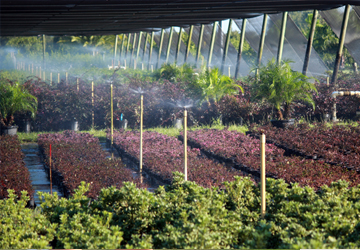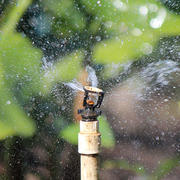
Irrigation can either increase your crop quality and yields, or damage your soils and slash your profits.
Most of us in the Ag industry know irrigation systems are essential for strong plants and crops. Unfortunately, we still see plenty of nurseries and greenhouses with runoff issues, nutrient leaching, and general water waste.
The ability to apply water efficiently and uniformly over a designated area has a major influence on the agronomic and economic viability of a nursery operation. Growers can increase their irrigation efficiency and virtually eliminate runoff, root disease, and aeration issues in their fields by following a few simple rules for proper irrigation design, operation, and maintenance.
Rule #1: Design it Right
Inappropriate system design is probably the biggest cause of inefficient irrigation. A badly designed system will not irrigate uniformly. With a bad design, be ready for overwatering, runoff or under watering.
Growers with an existing irrigation system may not want to hear that their overhead systems may need a re-design. However, an installation that correctly follows the equipment manufacturer’s recommendations can mean the difference between a healthy field and unmarketable crops.
When designing an efficient system, it is important to take spacing restrictions, operating pressure and application rate into consideration.
A common question asked is, “How long should I irrigate?” and there is no simple answer. It all depends on your system’s flow rate over a surface area.
In general, determining your application rate involves knowing how much water a specific crop needs at different growing stages and how easily the soil can absorb the water. For example, some tomatoes grown in containers may require irrigation more than once a day.
But it’s the field’s soil type that determines how much water needs to be applied each time the system is turned on.
Sprinklers need to be selected and spaced so as not to exceed the ideal application rates. They are designed to irrigate at specific flow rates and to reach certain diameters of coverage.
To obtain maximum efficiency and reduce runoff, the system design must work within the sprinkler manufacturer’s parameters. This includes spacing, flow rate, and pressure range.
Rule #2: Get the Best Sprinkler
The quality of a sprinkler can have a great effect on a system’s overall efficiency.
Most nursery growers are familiar with impact sprinklers, which require higher flows and pressures to operate.
These sprinklers also irrigate using distinct streams that instantaneously place their entire flow over a relatively small area. High-pressure impact sprinklers also create fine droplets that are easily carried by wind and rapidly evaporate in dry atmospheric conditions.
Growers can obtain greater irrigation efficiency with sprinklers that instantaneously cover their entire wetted circle. Having a larger instantaneous area of coverage helps eliminate dry spots, increase uniformities, maintain soil infiltration capabilities, and reduce soil structure degradation and run-off.
Equally important is using a sprinkler that can combat wind-drift and evaporation. Sprinklers that distribute water in consistently sized droplets help maintain pattern integrity in wind conditions.
Ideally, growers should have the largest droplet size possible that does not have adverse effects on soil or crop. Droplets that are too small are prone to wind-drift and evaporative loss, which lowers irrigation efficiency, and wastes water and energy.
Rule #3: Keep Your System in Check
Maintaining an overhead irrigation system is a little easier than keeping other systems in check, but that does not mean growers can forget about upkeep. Growers need to regularly inspect their overall watering system for leaks, broken lines, or damaged equipment.
They should also check their sprinklers while they are operating to pinpoint any issues such as overwatering, misting, misdirected patterns, or lack of uniformity. Clogged nozzles are usually the culprit behind pattern distortion.
On the other hand, issues like misting and overwatering may be due to changes in pressure and flow along the system. This just means a grower may need pressure regulators to keep efficiencies in check.
Sprinklers and applicators are designed to operate within a range of pressures that provide optimal performance. Unfortunately, system pressures will vary due to elevation changes in a field and pressure loss through pipefittings.
When pressures are too low, the sprinkler’s rotational speed is altered. This may lead to dry spots and under watering. Higher pressures can cause overwatering near the sprinkler head and create small droplets susceptible to wind-drift and evaporation. Pressure regulators eliminate these pressure fluctuations and help maintain sprinkler pattern integrity and performance.
Source
Published as "3 Essential Rules For Irrigation Efficiency In Nurseries". Vestnik Vegetable. January 2017. Print.



